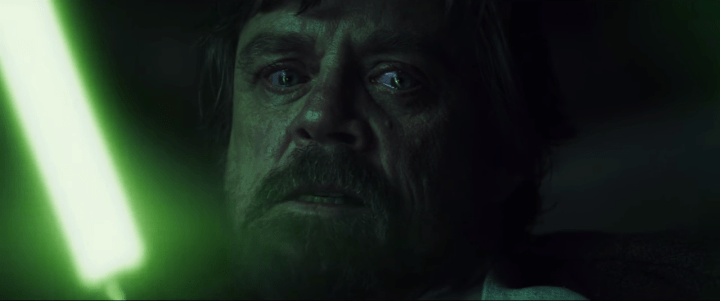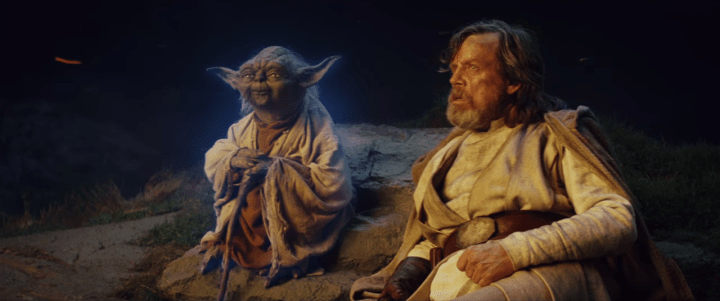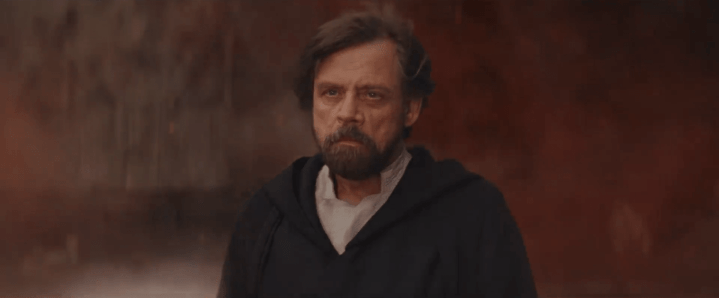
Ever since The Last Jedi was released, there has been a vocal (albeit relatively small) percentage of fans who are furious about it.
Some of these complaints can easily be dismissed because they are rooted in sexism, while others have taken to harassing the actors and people involved with the film and should be largely discredited. But then there are some whose complaints are worth considering, and of this group, it seems that much of the complaints are rooted in one main thing: it wasn’t what they wanted or expected. These fans may be the ones who cared deeply about the EU and therefore think the sequel trilogy doesn’t compare to some of those EU stories – in particular, the portrayal of Luke Skywalker.
These fans have claimed “Not my Luke Skywalker!” and have felt emboldened by Mark Hamill’s initial wrestling with the direction of the iconic character. They feel that Lucasfilm has betrayed the essence of one of the galaxy’s most beloved heroes. And if that were true, then certainly there is reason for criticism! But is it true? That’s the million dollar question, and it seems that may be what divides those who loved the film from those who hated the film (at least those who hated the film for the reason we have put forth in this article).
Today, then, we’re going to look at why I don’t think The Last Jedi betrayed Luke Skywalker’s character and how, in reality, Luke’s appearance on Crait may be one of the most heroic, Jedi-like things anybody has ever done.
Jedi in Exile

Before we get there, however, we have to talk about where Luke Skywalker is at when we first meet him in The Last Jedi. He’s in exile on Ahch-To, content to live out the rest of his days on the planet and die, allowing the Jedi Order to die with him. He has seen the damage the Jedi have done, and he views what he’s doing through the lens of tragic heroism: not only is his exile a sort of self-imposed punishment for failing the Jedi and his family, he also thinks that the best thing for the galaxy is to let the Jedi die. As such, he has tried to close himself off from the Force. He has run away, as Leia told him to in Return of the Jedi, but he soon realizes that the words of Darth Vader later in that film are equally true: “You cannot hide forever, Luke.” Despite Luke’s best efforts to pick up everything and disappear, his past confronts him – as does his future. Rey shows up with Chewbacca in the Millennium Falcon, and Luke realizes that his best friend, Han Solo, is dead. Then he finds out that his sister, Leia, is in dire need of help, and that his nephew, Kylo Ren, is helping the First Order take over the galaxy. Still not wanting to get involved, Luke continues to live out his daily routine on Ahch-To, but after taking a nostalgic trip onto the Falcon, R2-D2 – the loyal droid who was with Luke for so many of his adventures – plays Leia’s original message calling for help. It was the message that had gotten Luke involved in all of this decades earlier. Leia had been calling for help, and she now needed help once more.
Luke becomes more sympathetic to Rey’s plight, but he still maintains that the Jedi need to die. He explains that the legacy of the Jedi is failure, and any good student of Star Wars will realize that there’s a lot of truth to what he’s saying. The prequels showed very clearly how the Jedi were not the victims in the creation of Darth Vader. They didn’t exactly help things.
How did Luke get to this point, though? It’s actually a logical progression the more we get to know of what happened in-between Return of the Jedi and The Force Awakens.
A True Jedi

The pinnacle moment of the original trilogy came near the end of Return of the Jedi, after Luke Skywalker had bested Darth Vader in combat. At the end of The Empire Strikes Back we learned that Skywalker was the son of Vader, and in ROTJ there were clues dropped intended to make the audience wonder whether the son of Vader would follow in his father’s footsteps or not (like Luke dressed in black, force choking Gamorrean Guards, etc.). Then, in order to beat Vader, Luke gives in to his anger and uses that to propel him to a furious offensive that wound up in him cutting Vader’s hand off. That was when the Emperor offered Luke the chance to kill Vader and join him, ruling the galaxy. This was the moment that everything had built up to, but in this moment, Luke threw his lightsaber away. He refused to join the Emperor and give in to the dark side. “You’ve failed, your highness,” Luke tells Palpatine. Why had Palpatine failed? Because even if Luke’s life were to end moments later, he still wouldn’t have given in to the dark side. He had truly become a Jedi.
But as Jonathan McIntosh recently pointed out on Twitter, some fans seem to misinterpret this moment: Luke didn’t win because he bested Vader in combat; Luke won because he refused to fight the Emperor in combat. When Luke bested Vader, it was actually a moment of weakness – a stunning twist for an action movie like this. Luke gave in to his anger (yeah, it was in a desire to protect his friends, but, well, look at Anakin’s motivations for doing so in the prequels), cuts Vader’s hand off, and holds his lightsaber above him, ready to strike a fatal blow at any moment. But then Luke realizes that Vader is his father, realizes that this isn’t the Jedi way, realizes that he was wrong for giving into his anger, and throws his lightsaber away. He would rather die than fight Palpatine, rather die than give in to anger.
We of course know how things end: Vader, seeing his son’s refusal to fight Palpatine and seeing his son being shocked to death by the Emperor, intervenes and kills his master, saving his son’s life. Yet it wasn’t Luke defeating Vader that made him a Jedi (contrary to what Yoda had indicated earlier); it was Luke refusing to kill Vader that did so. Luke’s throwing away the lightsaber represented his crowning as a Jedi Knight. This has been widely recognized among fans since the movie came out, and Luke himself states it in the film: as he throws his lightsaber away, he says, “I am a Jedi, like my father before me.” Luke’s true Jedi moment came not from fighting but from refusing to fight.
Jedi Master

Almost immediately following the Battle of Endor, Luke Skywalker began his exploits of searching for Jedi lore and history. He traveled to Pillio to search one of the Emperor’s observatories and retrieve a compass, and he traveled to Vetine to recover a force-sensitive tree. One of his first stops in exploring the history of the Jedi Order was Gatalenta, and through his many exploits he came to recover the sacred Jedi texts and many other Jedi artifacts. Additionally, together with an explorer named Lor San Tekka, Luke discovered the location of the first Jedi Temple: Ahch-To. He hid that information away until he would have a use for the secret location years later. He taught his sister, Leia, about the Force, but she opted to not become his first pupil as the Jedi hoped. Luke instead took as his apprentices twelve people, including those whom he had met during his travels and his nephew, Ben Solo. Luke and R2-D2 took the apprentices to a secret Jedi Temple, known only to the Jedi Master, his droid, and his apprentices. He began to fulfill the final wish of Master Yoda: “Pass on what you have learned.” Luke was reviving the Jedi Order. But he sensed that Ben Solo had darkness in him, and when he went to confront the young man, Luke instinctively ignited his lightsaber upon sensing the evil. He quickly realized his mistake, but it was too late: Ben fought back, destroyed the Temple, and took some of Luke’s apprentices with him (presumably becoming the Knights of Ren) while killing the others.
So, to be clear, Luke Skywalker was the Jedi Master that so many fans wanted him to be. It’s just that, by the time The Last Jedi comes around, Luke has given up hope. His grand efforts had failed. So he picked up the Jedi texts and artifacts and headed for the first Jedi Temple, ready to let the Jedi Order die. Think about it: he had defeated Darth Vader and helped bring balance to the galaxy. He had done everything he could to help establish a new Jedi Order. But, in his mind, he had gotten arrogant and assumed he could stop the darkness rising in Ben Solo. Everything crumbled, and Luke was left with a horrible realization of failure. He had failed Obi-Wan and Yoda, as he didn’t bring the Jedi Order back. He had failed Han and Leia, as he had allowed their son to fall to the dark side. He had failed Ben Solo, as he contemplated killing his nephew for the briefest moment, but long enough. For that to happen, it’s understandable for anyone to become cynical and hopeless.
Legacy of the Jedi

Luke Skywalker’s opinion on the Jedi by the time of The Last Jedi is clear: “The legacy of the Jedi is failure, hypocrisy, hubris.” What happened to lead him to that point? Well, for one thing, he realizes that it was a Jedi who in many ways helped lead to the rise of Darth Vader. Those who watched the prequels know that it might as well be plural “Jedi,” because there were a lot of people who didn’t help things. But Luke has also realized his own failure, and realizes that the history of the Jedi is repeated failure. So it’s time to give it up.
But throughout the film, Luke recovers his faith in the Force and in the Jedi. So it would do us well to remember one very important thing about the Jedi, a thing they seemed to lose sight of in the last days of the Galactic Republic during The Clone Wars: Jedi are peace-keepers. This is, in fact, one of the very first things we ever learn about the Jedi in the Star Wars universe. In A New Hope, Ben Kenobi tells Luke: “For over a thousand generations the Jedi Knights were the guardians of peace and justice in the Old Republic. Before the dark times. Before the Empire.” The Jedi were the guardians of peace and justice. That was their role. Luke learns further, in The Empire Strikes Back, from Yoda. When Luke asks how he can know the good side from the bad, Yoda responds, “… A Jedi uses the Force for knowledge and defense, never for attack.” Yoda had earlier told Luke that “Wars not make one great,” a fitting reminder for audiences as it pertains to the Jedi. In the prequel films, it is once again made clear that the Jedi are peacekeepers. Mace Windu tells Chancellor Palpatine that there aren’t enough Jedi to defend the Republic in a full-scale war, because “We’re keepers of the peace. Not soldiers.” As The Clone Wars raged, the Jedi had no choice but to become involved and assume command of the massive Clone army, but still the Jedi struggled with their involvement in a war (for example, the Mace Windu comics detail some of this struggle).
Hypocrisy? The Jedi – who were peacekeepers, not soldiers – became soldiers for the sake of fighting for peace, but some became enamored with power. In the midst of all of this, they inadvertently led to the creation of Darth Vader and rise of Darth Sidious.
Return of the Jedi

So let’s bring everything together, shall we? I want to expand further on a meme that has been going around social media about the heroic act of Luke Skywalker appearing on Crait. We know that Luke Skywalker became a very powerful and successful Jedi Master, at least for a time. He defeated Darth Vader, refused to succumb to the dark side of the Force, helped bring about the New Republic, explored the history and lore of the Jedi, started a Jedi Temple and took on a dozen apprentices, etc. And the sequel trilogy also gives us many implications of Skywalker’s power. For one, the legend of Luke Skywalker is loud and clear, having become an almost larger-than-life myth. Supreme Leader Snoke realizes that if Skywalker were to return, a new Jedi would rise – thus making the First Order desperate to kill him. And when Luke shows up on Crait, Kylo Ren – the one who, besides R2-D2, probably was most aware of his old Master’s power – ordered every single gun in the First Order arsenal to fire. And when that didn’t kill Luke, Kylo’s reaction wasn’t one of skepticism but of shock. In other words: Kylo Ren realizes full well the power of Luke Skywalker, Jedi Master.
Luke had given up hope on the Jedi, but during the course of the film he recovered it. He reconnected with the Force, learned another lesson from Master Yoda, and was willing to let the past die in order to move forward into the future – a future in which the Jedi would not end with him. And then, in the moment of most dire need, when the Resistance realizes that none of their allies are coming to help, Leia’s most powerful ally shows up. Luke has an emotional reunion with his sister and then marches out to confront the entire First Order by himself. The remaining Resistance members watch in amazement as this larger-than-life legend appears, probably the first time most of them have ever seen Luke Skywalker. Luke marches out to stare down the entire First ORder with a laser sword – the exact thing that he mocked at the beginning of the film.
But we later find out that it’s only a projection of himself, as he’s still halfway across the galaxy on Ahch-To. Though it might not be what fans wanted, it is a remarkable display of Luke’s prowess in the Force. It’s a power we’ve only seen once before in Star Wars – Master Yoda does it once in Rebels – and we’ve never seen it to this extent. Luke is incredibly strong with the Force, and displays new powers – powers that, it seems, not even his old apprentice is aware of.
But in finding his faith in the Force once more, in showing up to save the Resistance and Leia, in using the Force to project himself, Luke does what might be the most heroic thing a Jedi has ever done. Why? Because Luke manages to face the entire First Order, including his nephew, Kylo Ren, and allows the Resistance to escape, all without even laying a finger on a First Order soldier. Remember, the Jedi are most foundationally peacekeepers, not warriors. Yoda told Luke three decades earlier that “A Jedi uses the Force for knowledge and defense, never for attack.” And so here, on Crait, Luke Skywalker does precisely that: he defends the Resistance while not attacking the First Order. He stops an entire army in its tracks through a non-violent display of remarkable Force prowess. That, my friends, is a true Jedi Master.
A Jedi’s Legacy

The legacy of the Jedi? Well, that is still up for debate. But the legacy of Luke Skywalker? The ending of The Last Jedi makes that very clear. He has inspired hope in the galaxy. He is that spark of hope that the entire movie was talking about. And he has ensured that Rey will live to preserve the Jedi Order. Like the Resistance soldiers who marveled at Skywalker’s appearance and like the broom boy on Canto Bight, people all around the galaxy are inspired by the larger-than-life legend of Luke Skywalker. Only this time, we know that it’s not a myth. Luke Skywalker was a powerful Jedi Master who attained a remarkable connection to the Force and in many ways rediscovered the heart of what it means to be a Jedi. Sure, he failed in many ways, but that doesn’t mean his legacy is failure. He became one with the Force, taking his place in the annals of Jedi history as one of its’ greatest Masters.